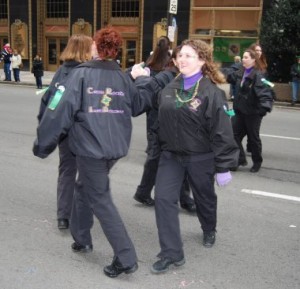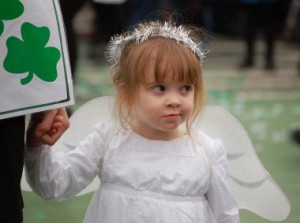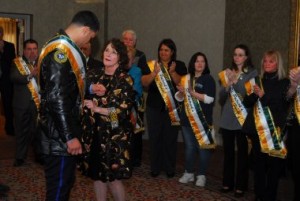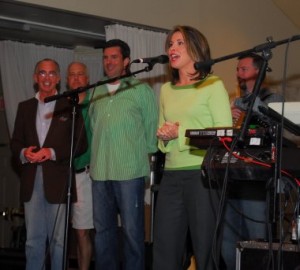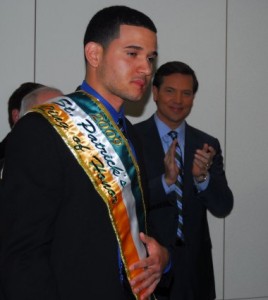Never make the mistake of calling Philadelphia’s Irish Memorial at Penn’s Landing the “famine memorial” in front of Jim Coyne. To Coyne, those dark years in Irish history when millions died and a millions emigrated to America, had nothing to do with famine. It was “starvation,” he says. What the Irish call “an gorta mor,” the great hunger. His great grandfather was one of those immigrants, a farmer who left his home in Connemara, County Galway “because the choices were clearcut—either you left or you starved to death.”
The truth, as Coyne points out, is that “only one crop failed”—the potato, on which the Irish were entirely dependent for food. “There were other crops that were exported to other countries while the Irish starved,” he says. “When you call it a famine, it’s as if you were blaming God for it. It wasn’t God. It was the English.”
When Jim Coyne looks at the sculpture by artist Glenna Goodacre, he sees in the 35 bronze figures—men, women, and children—ordinary people forced by prejudice and politics to become adventurers, people who climbed onto what were known as “coffin ships” to leave horror behind and sailed, some bravely, most terrified, into the unknown. Like his great-grandfather, who wound up in the coal mines of Pittston, PA, where Coyne grew up.
When others look at the memorial, they see Jim Coyne, president emeritus of the Irish Memorial Inc., who spent 13 years of his life working to see it built. “He’s an unsung hero,” says Michael Bradley, former president of the Philadelphia St. Patrick’s Parade Observance Committee, which chose Coyne as Grand Marshall of the 2009 parade. “Not only did he come up with the vision, he put together the team to raise the money—more than $3 million. I know how hard it is for me to raise the money for the parade, which is a fraction of that. I admire that he never gave up. Whenever I hear his name, I think ‘Gentleman Jim.’ He’s the perfect gentleman, and he’s a great human being.”
Coyne was at the meeting of the board of the Friendly Sons of St. Patrick in the late 1980s when historian Dennis Clark, PhD, author of “The Irish In Philadelphia,” proposed that a memorial be built in the city. “At the time, the only memorial to the starvation was in Quebec,” says Coyne. If anyone had had any doubts that one was needed, Coyne erased them when he asked the men in the room what they knew about the events that led to the Irish diaspora. “Only one person had a grasp of what happened. The rest said, ‘There was a famine and the Irish starved.’ So we knew there was room for education.”
Coyne, who heads his own company (Coyne First Aid, which teaches basic life support to diverse groups across the country), suddenly had a new job that would take more than a decade to complete. Originally, the Friendly Sons and the Memorial group that grew out of it wanted the memorial in place for the Sesquicentennial of the An gorta mort, 1995-2000, but the amount of money that needed to be raised pushed the unveiling to 2003.
He remains in awe of many of the organizations that supported the memorial from the beginning—so in awe, that he joined them. For example, he’s a member of the Ancient Order of Hibernians Sean McBride Division 2 in Glenside although he and his family (with wife, Ginny, he has 5 children, 18 grandchildren and 5 great grandchildren) have lived in Hilltown, Bucks County, for 30 years. “They passed out pamphlets during the St.. Patrick’s Day parade, collected money, held fund-raisers—I thought, I’d like to be involved with an outfit like that.”
Over the years, he’s also been president of the Galway Association, a member of the Irish Society, and is director emeritus of the Friendly Sons, which was founded in Philadelphia in 1771 and counted among its early members Commodore John Barry and at least nine other military men who distinguished themselves in the War of Independence.
But it may be the memorial of which he’s most proud. “When I look at it, I feel great personal pride,” he admits. “In the beginning, every time I would walk away from it I felt like I was leaving a child.”
“It’s a lasting contribution to the city of Philadelphia that will be there forever,” says Michael Bradley. “Jim has left his mark and a legacy to Philadelphia that will endure.”
And while his family is proud of Coyne’s work in the Irish community, his selection this year as parade grand marshal has created even more enthusiasm.
Last year, four generations of his family marched in the parade. This year, they may do some riding.
“When John Cardinal O’Connor of New York was grand marshal of the New York parade, he said, ‘My family is more excited and enthused about me being grand marshal of the parade than when I was made a cardinal.’ That’s true for me too,” he laughs.

